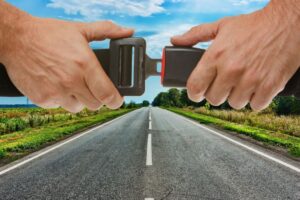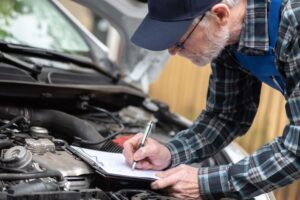Since modern vehicles are so full of car safety features, it might become confusing which feature performs which function and how to use each one.
Also, some may not always work, and they have their reasons for that. Regardless, you need to know about all of the safety features present in your vehicle and what function they perform.
The safety features in cars are referred to as vehicle safety technology. This special technology is developed to make cars much safer and secure than usual.
Vehicle safety technology includes many different projects and devices to help protect the car and passengers.
These include the more commonly known airbags, seat belts, bumpers, and antilock braking system as well as many newer and modern safety features such as pre-collision technology, blind spot warning, driver attention monitor and night vision, etc.
Other common safety features in cars are telematics, tire pressure monitor as well as four-wheel steering.
Many more safety features help protect you and your car against any accidents.
In this article, I will explain to you some of the most common and specific safety features included in more modern cars, their functions, and how they perform.
Table of Contents
- 1 24 Common Safety Features In Cars You Must Not Miss
- 2 Modern Car Safety Features For Your Safety
- 2.1 14. Pre-Collision Technology
- 2.2 15. Break Assistance
- 2.3 16. Blind Spot Warning
- 2.4 17. Pedestrian Detection
- 2.5 18. Lane Departure Warning
- 2.6 19. Parking Assist Systems
- 2.7 20. Backup Camera
- 2.8 21. Active Head Restraints
- 2.9 22. Automatic High Beams
- 2.10 23. Driver Attention Monitor
- 2.11 24. Night Vision
- 3 Conclusion
24 Common Safety Features In Cars You Must Not Miss

Many of the features I have mentioned below are common safety features, for example, airbags, seat belts, rearview mirrors, and car seat latches.
Other features are tire pressure m0onitor and pressure control etc.
Many of these are present in most if not all vehicles and are essential in protecting you and your vehicle.
However, there are some details as well, which I will now discuss.
1. Seat Belts
As you already know, Seat belts are included to take the pressure in the event of a frontal impact.
In addition, seat belts also keep the passengers in the right place to help airbags perform their function properly. Another feature of pre-tensioners is force limiters.
These take care of any force building upon the occupant’s chest by managing it well.
After the pre-tensioners are tightened, force limiters will allow the belt to reduce the force. Some vehicle models include inflatable seat belts.
This is a great feature because it will help reduce the harsh force that seat belts themselves out on the passengers.
This makes it very convenient for children and older individuals, as the seat belt force will not harm them.
The upper anchors in shoulder belts are adjustable, making a big difference. These will help keep the belt on the chest instead of the neck, avoiding any harm to the neck.
In addition, this makes seat belts comfortable for taller individuals as it won’t be putting a lot of pressure on their shoulders.
For more information, you can read this article on Seat Belt Safety Tips.
2. Latches
Latches are installed in all vehicles nowadays as they are required.
These are installed to help make it easier to install your child’s car seat, as the car seat to help protect against accidents will need these to properly attach itself to the vehicle.
They include top tether attachment points and built-in lower anchors and will work with any child seat that attaches using latches, making the entire installation process a lot easier.
This is great because installing a safety belt might be a bit dangerous compared to this.
However, installing the child seat with latches might be a bit complicated to figure out at first, so you might need help from tutorials.
3. Airbags
As you would already know, Airbags help in the event of a major car crash by inflating at the moment. These are a standard in all cars manufactured after 1998.
They operate by using crash sensors connected to an onboard computer and will detect any frontal collision, therefore triggering the bags to inflate.
However, if you aren’t using a seat belt, there is also a huge threat of injury or even death because of airbags, therefore wearing those is a must.
You should also remember to never place a rear-facing seat in the seats on the front that have airbags, as this can be dangerous.
Many airbags these days use great technology and can detect the weight, presence, and seat position of the front passenger and the driver.
Airbags also deactivate and depower as required to help avoid injuries to drivers closer to the wheel or other individuals in danger and children.
Side airbags are another safety feature to protect in case someone hits the sidewalls of the car.
These are much smaller cushions that will pop out the side of the seatback or out of the door trim.
These will help prevent injuries to the upper part of the body but aren’t as effective as protecting the head if it hits the sides. Most new models are featuring side-curtain bags as well.
These deploy from above the windows and will cover the rear and the front windows to protect passengers from hitting their heads hard on the sidewalls.
Not only this, but these side-curtain bags will also help protect against flying debris in the dangerous event of a cars crash. These also stay inflated much longer for safety reasons.
4. Traction Control
An electrically controlled system is traction control.
This will help to limit the wheel spin when the car is accelerating; therefore helping the drive wheels have as much traction as possible.
This makes this safety feature very useful when driving in icy or very wet conditions, as it will help prevent any slippage.
Moreover, this is also helpful when launching with an engine with high horsepower. Some of these systems only work when the speed is low, while others can work at any speed.
Most of these use the car’s anti-lock brake system to help brake the spinning wheel. Some might also use the engine by throttling back to it to prevent the wheel from spinning.
5. Stability Control
Stability control, also known as Electronic Stability Control (ESC), is a safety feature to help prevent the car from skidding or sliding anywhere unintended when making a turn.
This operates by using a few sensors. These detect the steering angle, wheel speed, rotation, and sideways motion to help prevent any accidents.
If, for example, the car goes away from where it was intended to go, this will put a brake on one or more wheels while reducing engine power to make the cars stop.
This is a very common safety feature but a standard in all cars since 2012, and it is included in most vehicles.
6. Antilock Braking System
Antilock Brakes System (ABS) help avoid any stopping and locking up of the wheels in hard conditions.
The sensors that this technology uses are present in the car’s wheels, and a computer will help to maximize any breaking action at every wheel.
This will help to give the driver much more control over the steering wheel, therefore helping to get the car moving should an obstacle come in the way.
However, it is to be noted that this does create a pulsing sensation that comes from the brake pedal whenever the antilock brakes come into action, so you should be aware of this because this will help to give you as much control and power as possible. What you have to do is just push harder on the pedal.
7. Telematics
Telematics uses GPS, Global Positioning Satellite Technology, and cellular telephone technology to operate.
Many modern cars include telematics to help drivers communicate with the central dispatch center by pressing a single button in an unfortunate event.
This will tell the location of the car while also getting directions as well as emergency aid in case an accident occurs.
This system will not only notify the dispatch center but also get your vehicle’s location while also getting you emergency service in case you don’t answer the phone inquiry.
Some car manufacturers actually use apps on your phone to help start the car, unlock it and beep your horn automatically in case your car is lost in the parking lot.
For most vehicles that have this system, the cost is included in the car price, but a monthly subscription fee of around $10 to $20 might also need to be paid, with smartphone apps also needing a subscription fee.
8. Tire-Pressure Monitor
Tire pressure monitors require a warning system for lower tire pressure.
This is because when the car tires are not inflated as required, the fuel economy, as well as the handling, can be negatively affected.
Not only this, but there is also a danger of blowouts because if tires are underinflated, they are more prone to getting damaged easily.
As tires lose the air through the rubber pretty slowly, drivers don’t usually realize this, but this helps to prevent this by either measuring tire pressure directly or by using sensors that count wheel revolutions to check how inflated tires are.
However, you should still check your tire pressure every month. If you would like to learn more about tires, you can read this article on Tires Safety Tips.
9. Lights
Three different lights help with the safety of your car. These are brake lights, headlights, and turn signals.
You should make use of all of these for maximum safety. In addition, you should also be checking the bulbs on a regular basis to see that they’re working properly.
If a bulb fails, then replace it as fast as possible, as any dangerous situation might arise.
Also, if you usually go on long routes during the night, then you should get HIDs or powerful bulbs installed in your vehicle’s headlights.
10. Mirrors
The side and rearview mirrors are essential in checking on the vehicles behind you to help prevent an accident.
You should always remember to make use of these when driving, as any vehicle could come from the back and hit you, and this should be prevented.
You should remember to position these properly as this will enhance visibility while also eliminating any blind spots.
11. Bumpers
A safety feature you did not notice but is also present is the bumper.
What makes this a safety feature is that it helps to withstand minor collisions with other vehicles, taking the damage while protecting the passengers in the vehicle.
These will help to prevent any damage from happening to the engine and the main body of the car.
12. Four-Wheel Steering
Four-wheel steering helps to give precise maneuvering ability when drivers are going at much higher speeds.
This feature helps prevent accidents and also helps to drive much easier when going to a hilly area.
13. Shatter Resistant Glass
The shatter-resistant glass is present in modern-day man vehicles.
This helps to provide a windshield that will break into numerous pieces that are harmless should an accident occur.
Vehicles that did not have shatter-resistant glass in the past were much more dangerous.
In these cases, if the windshield ever broke, the driver could be severely harmed due to being covered by shards of glass, but modern-day vehicles prevent that.
This shatterproof glass will therefore help to prevent many serious injuries.
Modern Car Safety Features For Your Safety
With modern cars with newer technologies and more expensive models, apart from other features these cars have, are included many new safety features.
Many drivers are not aware of these and how they perform. Therefore I will briefly explain some of these.
Among them are pedestrian warning, blind-spot assistance as well as parking assistance.
All of these help enhance the experience of the driver and further help prevent accidents and damage to your vehicle.
14. Pre-Collision Technology
Pre-Collision Technology is a safety feature present in many modern-day vehicles.
There are sensors present in the car which give protection against impacts whenever an upcoming collision is detected by them.
When this happens, the seat belts of the car get tighter, the airbags align, and the brakes also become preloaded to reduce any shock.
15. Break Assistance
A brake assistant present in the vehicle will detect whenever the driver makes a panic stop, i.e., whenever you make a sudden brake compared to the more gradual ones.
This feature, in this case, applies to brakes to the maximum force possible.
In addition to anti-lock brakes, this feature will also enable threshold braking, and the wheels won’t be locked up as well.
16. Blind Spot Warning
Blind Spot Warning uses radars and cameras. This will light up a light or an icon that is adjacent to the outside mirrors in order to warn if another car is in the lane beside you.
This is particularly helpful if the vehicle is unseen due to being hidden in your blind spot.
Some of these systems also have an audible warning to help warn about this, in case you are trying to move over.
Some advanced systems can actually brake or even steer your car towards the lane’s center.
17. Pedestrian Detection
Using the same features for detection as forward collision warning and automatic emergency braking; this safety feature helps to protect pedestrians.
The cameras in your car will detect any pedestrians that might come in the path of your vehicle.
Some even give an audible warning to alert you of this in case the collision seems high.
18. Lane Departure Warning
Lane Departure Warning will tell you if you ever steer the car out of the lane while having the turn signals not activated.
This uses lasers or cameras to monitor the lane markers, and this will blink a dashboard light or make a chime sound to alert you.
It could even vibrate the steering wheel or the seat to inform you about getting out of the lane.
19. Parking Assist Systems
Sensors present in the rear, front, and the bumpers will tell you when they sense that you are at a parking speed if there are any obstacles such as poles and walls close to you whenever you’re parking your vehicle.
This will help with safe parking without any bumping and damage to your car.
20. Backup Camera
This is a camera-based assistance system that turns on whenever your vehicle is in reverse mode. This will show the rearview in either the rearview mirror or the center console screen.
This is most helpful in safe parking but can also be useful in preventing collisions with children or pedestrians when driving backward.
21. Active Head Restraints
Active Head Restraints are features that will move upwards and forward should a rear crash happen to help absorb any energy as well as cradle the head.
This will help reduce the impact in some cases and mitigate whiplash injury.
22. Automatic High Beams
Automatic High Beams are features to help with nighttime visibility.
These will switch from high to low beams and keep alternating between these two to improve vision when driving your car at night, depending on what condition you’re in.
23. Driver Attention Monitor
The Driver Attention Monitor will help to keep an eye on the driver in cases of driving when sleepy or when drivers are distracted.
These systems use sensors that monitor the movement of the car as well as the volume of steering connections to see if the driver is driving properly or if they’re tired of using the phone.
In this case, the system will visually alert you or use audio to do so, asking you to take a break from driving if necessary.
The modern ones use driver-facing cameras to detect if the driver is being sleepy.
24. Night Vision
Lastly, Night Vision is a feature present in the more luxurious models and is not present in every vehicle as yet.
These are BMW, Mercedes-Benz, Audi, Cadillac, etc. this feature uses forward-facing thermographic cameras to detect any pedestrians, animals, or other vehicles that drivers cannot see easily due to the dark.
A small display screen will then show what is coming ahead, and the obstacles will be shown outlined in a heat signature to inform you to drive accordingly.
You may get a visual or audible alert depending on what system you’re using, therefore preventing any accidents that could happen due to less visibility.
Conclusion
With much advancement in modern cars, newer features are being added rapidly.
While some of these are quite complex to figure out, it is a great idea to be informed of all of the safety features your specific car has and how these will work to help you understand everything with much more ease.
I hope that this article helped to increase your knowledge of car safety features and their specific functions.
If you want to know about the ones in your specific car model, then consult the manufacturer of your vehicle.

I am Tahir Azam, and I have been writing amazing articles for TaxiHack for as long as I can remember. I know everything that is to know when it comes to automobiles and is always on top of industry news and developments. While I am not an expert by any means, I pride myself on knowing the ins and outs of many different problems and, of course, their solutions. The articles on our website are some of the best and well-researched content that you will find, and I spend countless hours making sure this remains to be true. This is why I ask you to take your time out and read some of my articles, especially if you find a topic that resonates with you or is something you are looking into. This way, you will find the perfect mix of information and tips on your desired topic. Learn more about Tahir.



